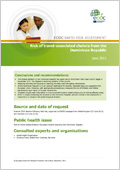# 6515
While the United States is in the midst of what may turn out to be its worst year for West Nile Virus since the virus arrived in 1999, to a lesser extent this mosquito-borne virus is making its presence known in Europe as well, particularly in Greece.
The ECDC released new maps today, along with reports of an additional 33 cases across the EU.
West Nile fever maps, 23 August 2012: 33 new cases in the EU and 46 in neighbouring countries
24 Aug 2012
ECDC
Thirty three new human cases of West Nile fever have been reported for the EU and 46 for its neighbourhood over the past week.
Twenty nine new cases were reported in Greece by the Hellenic Centre for Disease Control and Prevention (KEELPNO). Most cases, 26, were found in areas with previous case reports: in the prefectures of Attiki (3), Kavala (8), Samos (1), Thessaloniki (2), Xanthi (12). Two probable cases come found in the newly affected prefecture of Chalkidiki, and the location of one case is not known. (See KEELPNO Weekly bulletin for more information). New cases and affected areas in Greece are not unexpected given that since 2010 there has been progressive geographical expansion of West Nile virus transmission throughout the country, as stated in the recently published ECDC risk assessment on the epidemiological situation of West Nile fever in Greece.
For the first time this transmission season Romania reported cases of West Nile fever: three confirmed and one probable, in the Bucuresti municipality (Bucharest), Braila county and Ilfov county.
In neighbouring countries, Russia reported 42 new cases: 20 in new affected areas (Adygeya republic 2, Lipetskaya oblast 2, Novosibirskaya oblast 1, Rostovskaya oblast 13, Tatarstan republic 2) and 22 from Volgogradskaya oblast, an area with previous case reports.
The first cases in Serbia for the season were reported last week: one in Grad Beograd and three in Juzno-Banatski district.
Every Friday ECDC publishes on its website the West Nile fever maps, the information being based on cases reported up to the Thursday of each week.
Last July, the ECEC released a Rapid Risk Assessment on West Nile Virus after two cases were detected, very early in the season, in Greece.
Technical reports - 13 Jul 2012
Main conclusions and recommendations
On 7 and 10 July, the Hellenic Centre for Disease Control and Prevention (KEELPNO) reported the first two human cases of West Nile virus (WNV) infection in Greece this year. When looking at the epidemiology of WNV infection in Greece since 2010, one can observe a progressive geographical expansion of WNV transmission throughout the country. For this reason, these newly confirmed cases in Athens do not come unexpected.
However, the fact that the transmission occurred early in the season and that, for the first time, the cases were reported from neighbourhoods in Athens, indicate the need for a focussed public health response. Such response mechanisms are currently implemented in Greece, including enhanced surveillance for human cases, entomological surveillance, and vector control.
Given that West Nile season generally runs through October in parts of Europe, and the incubation period can be 2 weeks or longer, reported cases are expected to increase over the coming months.
Related Post:
Widget by [ Iptek-4u ]

